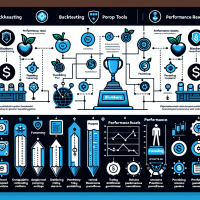FundedNext Record Rewards: Bonus Alternatives for Prop Trading Success (Mar 2025)
In today’s competitive prop trading landscape, simply relying on bonuses during evaluation is no longer a sustainable strategy. Prop trading firms are now turning to innovative performance rewards that incentivize traders based on real results. This article delves deep into the world of FundedNext record performance rewards, offering bonus alternatives that deliver clear, quantifiable benefits for prop traders. With a focus on actionable backtesting strategies and real-world application, we provide a blueprint for success in the evolving prop trading market as of March 2025.
Understanding FundedNext’s Bonus Alternatives
FundedNext has revolutionized the evaluation process by shifting the focus from one-time bonuses toward record performance rewards. This performance-based reward system not only motivates traders to refine their strategies on a daily basis but also aligns the success metrics of individual traders with the overall firm performance. The structure is engineered to reward consistency, risk management, and innovation.
What sets FundedNext apart is its transparency in measuring performance through advanced key metrics like Sharpe ratios, maximum drawdown, and profit factors. These metrics provide a clear, actionable guideline for both junior and senior traders, forming the foundation for developing robust trading strategies.

Figure 1: A screenshot of a performance dashboard highlighting key metrics such as Sharpe Ratio and drawdown from a popular backtesting tool like TradingView.
Advanced Backtesting for Prop Trading Excellence
One of the cornerstones for success in prop trading is robust backtesting. In the context of FundedNext, advanced backtesting techniques allow traders to simulate market conditions, optimize parameters, and stress test strategies efficiently. Backtesting tools such as TradingView, NinjaTrader, Backtrader, and QuantConnect are popular among prop traders for their comprehensive features:
| Tool | Backtesting Features | Data Quality | Integration | Pricing & Use Cases |
|---|---|---|---|---|
| TradingView | Vectorized, commission/slippage handling | Extensive historical data, multi-asset | API integration, broker links | Retail, prop trading; free trials available |
| NinjaTrader | Event-driven, high-frequency compatible | Detailed tick data, diverse assets | API, extensive analytics integrations | Prop firms, advanced traders; multiple pricing tiers |
| Backtrader | Automated parameter optimization | Good historical depth, community sourced | Python API, integration with pandas | Open source, adaptable for firm-level testing |
| QuantConnect | Cloud-based, robust optimization | Comprehensive data sets, real-time feeds | Broker integrations, algorithm library | Both retail and institutional; free tier available |
Best Practices in Advanced Backtesting
To extract maximum value, consider these best practices:
- Avoiding Overfitting: Use cross-validation techniques and out-of-sample testing to validate strategy robustness.
- Walk-Forward Analysis: Implement a rolling window approach to adapt to changing market regimes.
- Mitigating Bias: Adjust for survivorship and look-ahead biases by using accurate historical data and maintaining strict simulation parameters.
- Integration with Forward Testing: Combine results with paper trading to monitor metrics like maximum drawdown and profit factor before live deployment.
Automating the Backtesting Process
Automation has become a vital element for prop trading firms looking to scale their operations. Modern tools like MetaTrader 5 not only run historical backtests but also automate parameter optimization and scenario analysis. By using automated frameworks, traders can generate detailed performance reports that facilitate rapid strategy refinement.
import backtrader as bt
class TestStrategy(bt.Strategy):
def __init__(self):
self.sma = bt.indicators.SimpleMovingAverage(self.data.close, period=15)
def next(self):
if self.data.close[0] > self.sma[0]:
self.buy()
elif self.data.close[0] < self.sma[0]:
self.sell()
cerebro = bt.Cerebro()
cerebro.addstrategy(TestStrategy)
# Assume data is loaded here
result = cerebro.run()
print('Strategy completed')
This Python snippet using Backtrader demonstrates a simple moving average strategy. Such code snippets are invaluable for illustrating how automation in backtesting works in practice.

Figure 2: A sample automated backtesting report generated from MetaTrader 5, showcasing detailed performance metrics and scenario analyses.
Case Study: Enhancing Prop Trading Returns
Consider a leading prop trading firm that transitioned from evaluation bonuses to performance rewards last year. The firm implemented a systematic backtesting system integrating TradingView and QuantConnect, allowing its team to identify and mitigate risks effectively. Key challenges included market volatility and matching real-time execution with simulation outputs.
By leveraging walk-forward optimization and rigorous out-of-sample testing, the firm achieved a significant improvement in its Sharpe ratio—rising from 1.2 to 1.8—while reducing maximum drawdown by 15%. This case emphasizes that advanced backtesting methods, coupled with automated tools, are critical for sustaining competitive performance in prop trading.
Regulatory Compliance and Risk Management
Prop trading firms must also navigate a complex regulatory landscape. In regions governed by MiFID II, ESMA, or NFA rules, compliance is paramount. Firms should integrate compliance monitoring within their backtesting frameworks to ensure that trading algorithms not only perform well but also adhere to legal standards.
For risk managers, setting specific benchmarks—such as a profit factor above 1.5 and a Sharpe ratio target exceeding 1.5—is vital. Advanced tools automate these assessments, ensuring a balanced approach between growth and risk mitigation, thus aligning with the firm's overall compliance framework.
Actionable Insights and Next Steps
As prop trading evolves, so do the strategies that drive success. For those looking to refine their approach, consider these actionable insights:
- Leverage Automated Backtesting: Streamline your strategy development with tools such as NinjaTrader and QuantConnect, focusing on mitigating biases and validating strategy robustness.
- Embrace Regulatory Tools: Integrate compliance checks within your trading algorithms to adhere to global regulations like MiFID II and ESMA.
- Participate in Prop Trading Communities: Share insights and case studies with peers to continually enhance your trading approach. For more detailed strategies, explore our internal guides on Advanced Backtesting Techniques and Prop Trading Risk Management.
To stay ahead in this fast-paced environment, consider downloading our comprehensive Risk Management Checklist template, which breaks down key performance indicators and setup procedures to ensure that every trade aligns with your firm’s standards. This checklist offers a step-by-step framework to integrate historical testing with live, forward testing practices.
In conclusion, FundedNext's move towards performance rewards over traditional bonuses represents a significant shift. Prop trading professionals are encouraged to adopt advanced backtesting techniques, automate strategy performance tracking, and integrate rigorous compliance systems. By doing so, traders and prop firms alike can enhance their competitive edge and maximize returns in an ever-evolving market.
For those seeking further expert guidance, subscribe to our newsletter, attend our upcoming webinar on automated backtesting strategies, or join our community forum to discuss these innovative methods with industry leaders. As of March 2025, the emphasis on performance-based rewards continues to drive success in prop trading.







